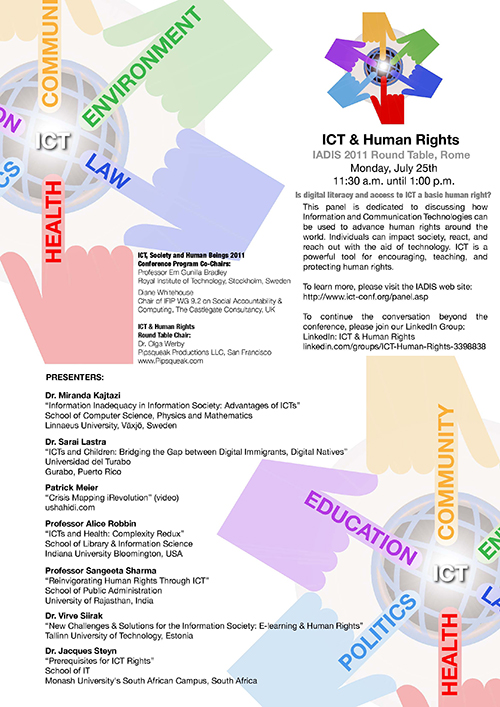
Here’s a nice collection of bus ads. The design of the ads was carefully targeted to the delivery vehicle (pun intended). Enjoy!

ICT & Human Rights Panel at IADIS The presenters in attendance, in order of presentation: Professor Sangeeta Sharma Title of presentation: Reinvigorating Human Rights Through ICT School of Public Administration University of Rajasthan, India Professor Alice Robbin Title of presentation: ICTs and Health: Complexity Redux Indiana University Bloomington Dr. Sarai Lastra Title of presentation: ICTs and Children: Bridging the Gap between Digital Immigrants, Digital Natives Universidad del Turabo Gurabo, Puerto Rico Dr. Miranda Kajtazi Title of presentation: Information Inadequacy in Information Society: advantages of ICTs School of Computer Science, Physics and Mathematics Linnaeus University, Växjö, Sweden Dr. Jacques Steyn Title of presentation: Prerequisites for ICT Rights School of IT Monash South Africa Patrick Meier and Dr. Virve Siirak were unable to attend in person. I summarized Patrick’s work in my opening statement and I hope Dr. Siirak would comment on his work below or on our LinkedIn community (ICT & Human Rights—all are welcome to join our open group). Opening Statement I chose to introduce each subtopic of the panel as part of my opening statement and to give it a slightly unusual take for each topic. Below are my notes and I’ve posted the PDF of my KeyNote on…

Some p-prims are harmless, but some can lead to serious bodily harm. The image above shows villages in Indonesia lying on an electrified railway track. Why? They believe this will improve their health. Their p-prim has to do with medicine: “electricity can cure some diseases.” This is not totally untrue, as is the case with all p-prims. Ultrasound therapy helps heal certain muscle strains, and the ultrasound machine runs on electricity. Heat lamps are also commonly used therapeutically. And they too require electricity. There are many, many other examples. It’s easy to explain how such folksy wisdom gets passed around the community. The problem with this particular p-prim is the resulting decisions that people make based on their beliefs in the curative power of electricity. How would a poor farmer in Rawa Buaya, outside Jakarta, get electricity? The most accessible source is this railway track. A tragedy is only a train away…
“Lost in Translation” was a wonderful movie by Sofia Coppola, starring Bill Murray and Scarlett Johansson. It depicted the delicious confusion of Western tourists in total Japanese cultural emersion. In particular, the scenes where Bill Murray shoots a liquor commercial for the Japanese market are simply priceless. In retrospect, I see where Ms. Coppola got her ideas. Her cousin, Nicholas Cage, have been making wonderfully odd (to our sensibilities) commercials for years. He clearly had stories to share. Here are a few of his gems, courtesy the World Wide Web: and But it’s not only Japan that surprises our/my cultural biases. This morning, my husband and I went to a local grocery store in Rome, Italy. In the cheese section, there was a little paper bottle of parmesan cheese with a mouse of the package. The mouse didn’t work for me at all! So much for cultural differences. Here’s a small collection of ads for McDonalds from all over the world. Please compare it to the packaging and menus for this restaurant chain that I’ve posted here in the past: “Cultural World Domination”. Notice all of the anchoring errors, metaphor mistakes, cultural biases, mirroring errors, and general cognitive and cultural…

We’ve traveled to Rome for our family vacation this year, and aside from a few summer reading books that I couldn’t find in an eBook format, we relied on our two Kindles and 3 iPads for our family reading needs. This is the second summer we brought primarily electronic versions of books—”The Count of Monte Cristo” is much easier to read when it fits into your hand and doesn’t weigh a ton… In the days before the Kindle and iPad, we carried an extra suitcase just for books. But there are drawbacks to buying and reading eBooks. Below are some of my thoughts and experiences—the cogitations of a voracious reader. Time & Progress As I was reading my novels, I found myself repeatedly trying to figure out where in the book I was. How far along was I? When is the next natural break (chapter, section end)? How many pages are there to the end of the chapter, end of the section, end of the book? These were not idle curiosities about my reading accomplishments, although when you do finish reading the book version of “The Count of Monte Cristo”, you do have a sense of having read something. An…
Making Money on a Bet Yesterday, I came across a little post on LinkedIn: L.G. update: “I have a bet with one of my colleagues today. He thinks that using LinkedIn is a waste of time and does not see the benefit. So he has agreed to give me £1 for every like/comment I get. Considering I have over 2000 connections I reckon I will get £300 easy out of this. Start liking this update people!” It wasn’t from anyone I knew. But a LOT of people I did know (and are linked to) commented and liked this update. I added my like as well. To date (the original comment was made 2 days ago), there are 6,298 likes and 1,286 comments! Mr. L.G. stands to make some money here. With Google+, Facebook, Twitter, and the like, all pushing the value of social networking, it was interesting to see this little experiment making a direct conversion from social networking to money. And it’s not over—the post sparked an emotional response among the members of LinkedIn. The emotional trigger is still there. With each new like and comment, the temptation to add another like on the pile grows. It’s contagious!

In the spirit of Animaniacs’ “Bad Idea, Good Idea,” enjoy the following product ideas. And for those who’ve never heard of Animaniacs, please watch the short segment (you can see more on YouTube!). Need a bit of assist in your bedroom? Add springs for the extra bounce. Find yourself in need of a sure grip? Make room for fingers. Short on space? Don’t waste the cupboards under each stair. Need more animation in the morning? Use the light. Bored with tea? Get a personal assistant. Worried about your waistline? Get measured. Live to serve? Bump it up. Too sure-footed? Make every climb a challenge. Too close? Give your photos some distance. Product design is limited only by imagination. A Short Introduction to Animaniacs’ “Bad Idea, Good Idea”